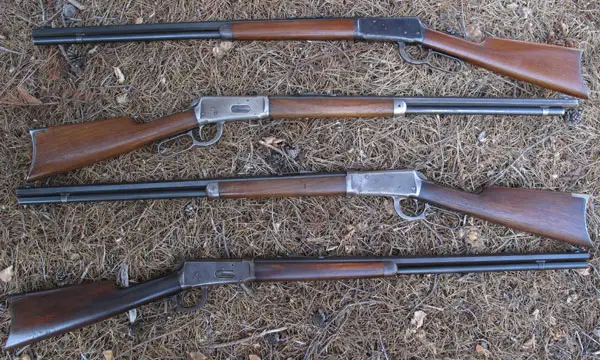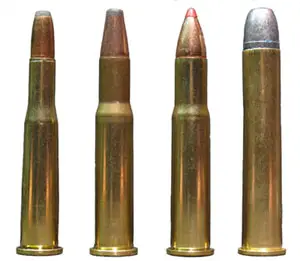|
Four Winchester Model 1894 Rifles (.25-35, .30-30, .32 Spec. and .38-55) By the Guns and Shooting Online Staff  Over the last year or so, Guns and Shooting Online Gunsmithing Editor Rocky Hays purchased four Winchester Model 1894 rifles in four classic Winchester calibers: .25-35, .30-30, .32 Special and .38-55. Three of these rifles have 26" full octagon barrels (the .30-30 has a 24" octagon barrel) and all have straight hand stocks with traditional "rifle" crescent butt plates. These rifles will ultimately form the basis of a matched, four caliber set of fully refinished, upgraded, engraved and restocked (in fine walnut), Model 1894 Winchesters that he will create. Each receiver will feature an engraving of an appropriate game animal, a pronghorn antelope for the .25-35, buck deer for the .30-30, black bear for the .32 Special and an elk for the .38-55. Part of the attraction is that all four rifles were made in 1907, the last year of Model 1894 production before the model designation was changed to simply "Model 94" in 1908. We will do a future article about these four rifles after the project is completed. The .25-35, .30-30, .32 Winchester Special and .38-55 calibers are all based on the .38-55 case, necked-down in the case of the three smaller calibers. Ammo is factory loaded for all of these cartridges by one or more of the four major U.S. ammunition manufacturers. Indeed, the .32 Special remains a popular deer and black bear cartridge with factory loads available from all four (Federal, Hornady, Remington and Winchester), while the .30-30 is one of the best selling hunting cartridges in North America and factory loaded ammo is available around the world. The .25-35 and .38-55 are also excellent hunting and recreational shooting cartridges and have been making a modest comeback, due to the recent production of modern rifles in both calibers.  These four classic rifles are in good condition. Not pristine collector's rifles, by any means, but solid shooters that have done their fair share of hunting and show normal wear for rifles well over 100 years old. The barreled actions are blued and the black walnut stocks show their share of dings and wear. The .25-35 rifle is in the best condition, shows the least wear and retains most of its original blued finish. It is also fitted with a folding tang sight for faster and more accurate shooting, as the others will be when the matched set is completed. (This rifle is featured in an article on the Collectors Corner index page.)  The .30-30 rifle probably shows the most finish wear. The .38-55 shows evidence of having been carried many miles by hand, as does the .32 Special. All three have apparently been hunted extensively. The .30-30, .25-35 and .38-55 barrels are all in good condition and the .32 Special barrel is in fair condition with some pitting. However, we discovered that all four rifles, including the .32 Special, are good shooters. We bet that these rifles could tell some great hunting stories, if only they could talk. Here are the basic specifications of our 1907 vintage Model 1894's:
The Model 1894 action was designed for Winchester by none other than John Moses Browning in 1893. Its action is more compact and much stronger than the earlier B. Tyler Henry designed, toggle-link action Winchesters and it handles long cartridges much more efficiently. It became the best selling lever action rifle of all time, with over 7,000,000 produced and still counting. Despite their slender profile and rifle butt plates, these are mild kicking rifles, easy to shoot accurately. (Assuming the shooter's eyes are up to the task with iron sights!) The Model 1894 was the first civilian rifle chambered for cartridges using smokeless powders. The .30-30, the first North American smokeless powder hunting cartridge, was introduced in Winchester's new Model 1894 rifle in 1895. The best things about any Model 1894 rifle are its balance, handling qualities and fast, reliable action. Handling and carrying a Model 1894 in the field is a pleasure. Its clean lines, straight hand stock, slender receiver and full length magazine achieve an aesthetic perfection seldom approached by modern rifles. Its durable steel and walnut construction make the Winchester Model 1894 the epitome of a hunting rifle that can be handed-down from generation to generation. As one might expect of rifles manufactured in 1907 by one of the world's premier gun companies, these rifles are built entirely of forged steel parts and walnut. They were assembled by skilled workers who obviously took pride in their workmanship. Safety is provided by a hammer safety notch. When the chamber is loaded, manually lower the hammer from the full-cock position until it engages the safety notch (about 3/4 of the way down). This is easy to do. Keep the muzzle pointed in a safe direction while you are lowering the hammer. Yes, the hammer can be forced by a very heavy blow, such as might be delivered by a carpenter's hammer, but so what? This is not going to happen in the field. As usual, we did our shooting at the Izaak Walton outdoor range south of Eugene, Oregon. This facility offers covered bench rests with target stands at 25, 50, 100 and 200 yards. We did some 100 yard plinking, but we confined our shooting for record to three shot groups at 50 yards, which is as far as our aging eyes can realistically stretch iron sights. The bulk of the shooting was done from a bench rest using a Caldwell Lead Sled by Guns and Shooting Online staff members Chuck Hawks, Gordon Landers, Rocky Hays, Jim Fleck and Schuyler Barnum .30-30 and .32 Special ammo is widely available and offered by all major U.S. suppliers. Our .30-30 test ammo was the standard factory load using a 150 grain soft point bullet at a MV of 2390 fps, in this case from Federal Cartridge. We used Hornady LeverEvolution cartridges in .32 Special, which launch a 165 grain FTX bullet at 2410 fps. Winchester, alone among the majors, offers a .25-35 factory load. It launches a 117 grain Soft Point bullet at a MV of 2230 fps and this is the .25-35 ammo we used. Winchester Ammunition also offers a .38-55 factory load, but we had none on hand. Therefore, our .38-55 test ammo was a handload using a medium charge of 4895 powder behind a .380" diameter, 260 grain, cast lead alloy bullet with gas check at a MV of 1500 fps. Incidentally, the .380" diameter bullet was chosen over the .375" bullets more common today to match the rifle's .380" groove diameter. This is a true .38 caliber rifle. Shooting results at 50 yards · .25-35, 117 grain: Smallest group = 3/8", Largest group = 2-3/4", Mean average group size = 1.64" · .30-30, 150 grain: Smallest group = 5/16", Largest group = 1-3/4", Mean average group size = 1.15" · .32 Sp., 165 grain: Smallest group = 7/8", Largest group = 2-3/4", Mean average group size = 1.73" · .38-55, 260 grain: Smallest group = 1-1/16", Largest group = 1-7/8", Mean average group size = 1.47" As you can see from the above recorded groups, the shooting results were good, actually better than we expected. We found the old rifles capable of averaging 2" to 2-1/2" groups at 100 yards, when we were able to do our part with the iron sights. We all agreed that the limiting factors were the buckhorn rear sights and our inferior eyes. Interestingly, all four rifles shot to the approximate point of aim. They had obviously been sighted-in by their previous owners. We felt that the rifles had more accuracy potential than we could take advantage of with iron sights and all four could be taken deer hunting as is. Model 1894's eject fired cases up and over the shooter's shoulder when the lever is operated rapidly. The big advantage of this system is the Model 1894's open top receiver, which makes it easy to single load cartridges, or to clear a jam in the unlikely event one should occur. As expected with well broken-in Model 1894 rifles, there were no malfunctions during our range time. With the loads we were shooting, the .32 Special kicked the hardest and the .25-35 and .38-55 kicked the least, with the .30-30 somewhere in-between. That is not surprising, since the .32 Special was shooting the hottest and most modern load. The Hornady LeverEvolution load makes the .32 Special an effective 200 yard elk slayer. Winchester and Marlin should reintroduce the .32 Special in their modern lever action rifles (Model 94 Sporter and Model 336XLR) to take advantage of this potent load. Perhaps the most pleasant surprise was the .38-55 rifle, the caliber with which we have the least collective experience. We all loved it. It was a consistent performer, the recoil is light and it is great fun to shoot. The big bullet travels at a leisurely rate, so when shooting at 100 yards there is a perceptible (although brief) delay between the rifle firing and the clearly heard slap of the bullet hitting the target. Managing Editor Chuck Hawks was so impressed that he immediately requested a new Winchester Model 94 Sporter rifle in .38-55 caliber for a full Guns and Shooting Online review, which you can find on the Rifle Information page. We had a lot of fun shooting these classic Winchester Model 1894 rifles. Chuck, Gordon and Jim are lifelong lever action aficionados, while Rocky and Schuyler generally favor bolt actions. However, everyone was impressed by the performance of these Winchester Model 1894's and each of us longed to take one of these rifles deer hunting. The finished matched set will be priced well beyond our modest means, but we hope the ultimate owner uses each rifle to bag the game animal that will be engraved on its receiver. That would be the most fitting tribute to these fine hunting rifles. |